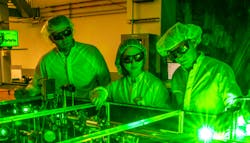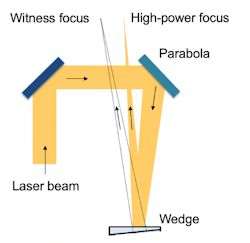Novel optical system is promising for more precise high-power laser control
The Berkeley Lab Laser Accelerator (BELLA) Center at the Department of Energy’s Lawrence Berkeley National Laboratory (Berkeley Lab; Berkeley, CA) has developed and tested an optical system to precisely measure and control the position and pointing angle of high-power laser beams with unprecedented accuracy, without interrupting or disturbing the beams. The system will help users throughout the sciences get the most out of high-power lasers.
The heart of this new approach is a laser architecture with three key attributes. First, it simultaneously provides five high-power pulses and a thousand low-power pulses per second, all following the same path. Second, the beamline design is optimized to keep the high- and low-power pulses matched in size and divergence. Finally, it replaces one of the reflective beam line mirrors with an innovative wedge-shaped reflector that has specialty coatings on both the front and the rear surfaces.Almost all of the main beam is reflected off the front surface of the optic without otherwise being noticeably affected. A tiny bit of the beam, representing perhaps 1% of the input power, propagates through the front surface and is reflected off the rear surface. This “witness beam” goes through any subsequent optics almost in parallel to the main beam, with just enough diversion for easy placement of measurement instruments. The end result is a witness beam with pointing angle and transverse position highly correlated to those of the main beam, and is “a measurement that won’t interfere with the main laser beam, yet very accurately tells us about it,” explains doctoral candidate Fumika Isono of Berkeley Lab and UC Berkeley, who led the work.
A near-future goal is using this diagnostic as part of a feedback system for active stabilization of the laser’s transverse position and pointing angle. Preliminary studies with the 100-terawatt laser at BELLA Center have been promising. The manuscript lays out the prospect of removing the jitters on the high-power 5 Hz laser by actively stabilizing the low-power 1 kHz laser pulse train. Laser beam vibration and motion was observed to occur on a scale of a few tens of hertz, which is well within the range of a practical feedback system. A fivefold improvement in position and angle of high-power laser pulse delivery is expected.
The development of laser-plasma particle accelerators (LPAs), which is the primary mission of the BELLA Center, exemplifies the potential benefit of this innovation. LPAs produce ultrahigh electric fields that accelerate charged particles very rapidly, thereby offering the promise of a next generation of more compact, more affordable accelerators for a wide variety of applications. Since LPAs perform their acceleration within a thin hollow tube, or “capillary,” they would benefit greatly from improved control of the drive laser beam position and pointing angle.
One immediate application at the BELLA Center is the use of a laser-driven plasma accelerator (LPA) to provide electron beams for a free-electron laser (FEL)—a device that produces bright photon pulses at a far higher energy and shorter wavelength than visible light. “The undulator, the magnetic array at the heart of the FEL, has very strict requirements on electron beam acceptance, which directly relates to the LPA drive laser pointing angle and transverse fluctuations,” says Isono.
The proposed kBELLA, a next-generation laser system that will combine high power with a kilohertz repetition rate, will be another likely application.
Interest from laser labs worldwide is anticipated. “This work is not limited to laser-plasma acceleration,” says BELLA Center Director Eric Esarey. “It addresses a specific need throughout the high-power laser community, namely, proving a correlated low-power copy of the high-power pulse without significant interference. Anywhere a high-power laser beam needs to be delivered with some precision to any application, this diagnostic is going to make a big difference. Think of laser-particle collision experiments, or laser interactions with micron-precision targets such as capillaries or droplets.”
Full details of the work appear in the journal High Power Laser Science and Engineering.

